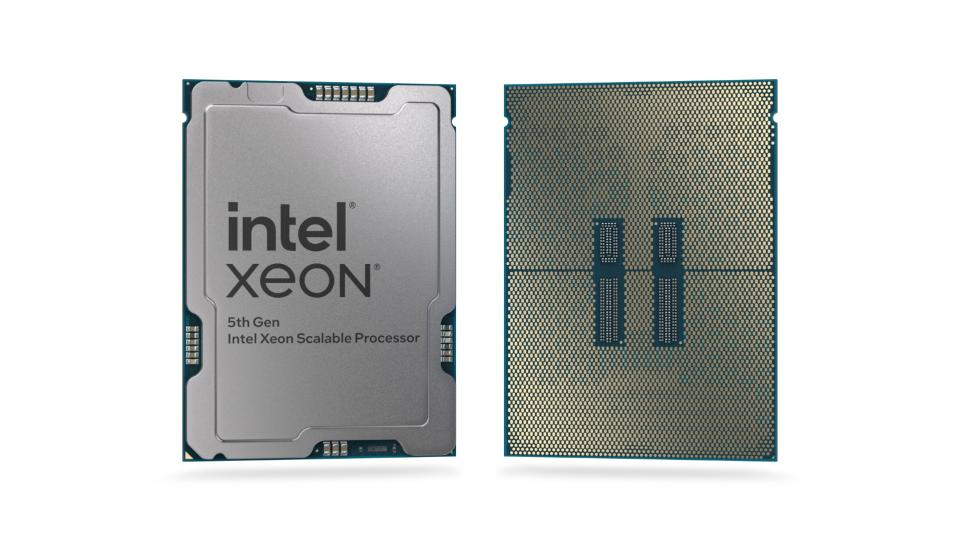
Emerald Rapids, the latest generation of Xeon server CPUs from Intel (NASDAQ: INTC), officially launched on Dec. 14. While Emerald Rapids uses the same Intel 7 manufacturing process as Sapphire Rapids, which launched in January, architectural changes, coupled with a vast increase in cache memory, deliver impressive performance gains.
Advanced Micro Devices' (NASDAQ: AMD) Genoa server CPUs still hold the advantage for workloads that can make good use of many cores. While Emerald Rapids chips go up to 64 cores, Genoa goes up to 96 cores.
But core count is only one part of the equation. The Tom's Hardware website ran the top-tier Platinum 8592+ from Intel's Emerald Rapids family through its paces, and the results make it clear that Intel has gained considerable ground on AMD.
Strong AI performance
Depending on the model, Emerald Rapids chips include various built-in accelerators aimed at specific types of workloads. The Platinum 8592+ includes each type of accelerator Intel offers, including one that accelerates AI workloads.
Along with the built-in AI accelerator, a few other changes helped Emerald Rapids deliver impressive performance gains. Intel switched up the design from Sapphire Rapids, moving to a simpler tile-based design that eliminates some issues with latency. For AI workloads, in particular, moving data quickly is paramount. The higher-end Emerald Rapids chips also offer more than triple the L3 cache as Sapphire Rapids.
Emerald Rapids puts up a strong showing in the AI workloads Tom's Hardware used in its review. Interestingly, AMD's 96-core Genoa chip falls flat in all the tests using the popular TensorFlow AI software, coming in dead last by a wide margin. The large number of cores and the latency introduced by AMD's tile-based design seem to be problematic for these workloads. Tom's Hardware was unable to test AI models that benefit the most from Emerald Rapids' built-in AI accelerators, but even so, the chips registered strong AI performance.
Emerald Rapids scores some wins outside of AI workloads, particularly in workloads that can't make good use of AMD's higher core counts without running into bottlenecks elsewhere. AMD's Genoa still reigns supreme in workloads like rendering, although Emerald Rapids makes significant gains over Sapphire Rapids in many areas and is competitive against AMD's 64-core models.
Concluded Tom's Hardware: "...the Emerald Rapids 8592+ grapples with AMD's competing 64-core models in a core-for-core battle that finds it winning in more than a few key areas."
Paving the way for Granite Rapids
Emerald Rapids improves Intel's position in the server CPU market, and it cements its lead over AMD in AI workloads. While the large language models that continually make headlines require powerful GPUs for both training and inference, many AI inference tasks are well suited to run on CPUs.
That's the market that Intel is going after with Emerald Rapids. In seven out of nine AI tests run by Tom's Hardware, Intel's chips come out on top, sometimes by a large margin.
AMD still holds the advantage in general-purpose computing, but Intel will look to change that in the first half of 2024 with Granite Rapids, the successor to Emerald Rapids. Granite Rapids will likely boost the core count considerably over Emerald Rapids, and the upcoming chips will be built on the Intel 3 manufacturing process. Intel will also launch Sierra Forest around the same time, a second family of server CPUs that use weaker cores but pack as many as 288 cores into a single chip.
Emerald Rapids certainly isn't a Genoa killer, but Intel has made impressive gains over Sapphire Rapids and wins against Genoa in a variety of workloads. Granite Rapids should bring even larger performance gains, although AMD is expected to launch its next-generation Turin server chips by the end of next year.
As AI workloads proliferate, Intel's Emerald Rapids should find plenty of customers looking to accelerate inference tasks.
Should you invest $1,000 in Intel right now?
Before you buy stock in Intel, consider this:
The Motley Fool Stock Advisor analyst team just identified what they believe are the 10 best stocks for investors to buy now... and Intel wasn't one of them. The 10 stocks that made the cut could produce monster returns in the coming years.
Stock Advisor provides investors with an easy-to-follow blueprint for success, including guidance on building a portfolio, regular updates from analysts, and two new stock picks each month. The Stock Advisor service has more than tripled the return of S&P 500 since 2002*.
*Stock Advisor returns as of December 11, 2023
Timothy Green has positions in Intel. The Motley Fool has positions in and recommends Advanced Micro Devices. The Motley Fool recommends Intel and recommends the following options: long January 2023 $57.50 calls on Intel, long January 2025 $45 calls on Intel, and short February 2024 $47 calls on Intel. The Motley Fool has a disclosure policy.
Intel's New Server Chips Make Gains on AMD was originally published by The Motley Fool
"chips" - Google News
December 16, 2023 at 07:20PM
https://ift.tt/O3dMAwH
Intel's New Server Chips Make Gains on AMD - Yahoo Finance
"chips" - Google News
https://ift.tt/xGvolkC
https://ift.tt/lxL1SNb
Bagikan Berita Ini














0 Response to "Intel's New Server Chips Make Gains on AMD - Yahoo Finance"
Post a Comment